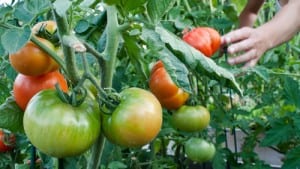
California processing tomato harvest is underway, and with lower prices this year, growers say they will need a good crop if they want to see decent returns.
While it is still early in the harvest season, Yolo County farmer Bruce Rominger, who started harvest last week, says his crop so far “looks about average—not that great, but not horrible.”
Similar reports are coming from growers in the southern San Joaquin Valley, which started harvest in late June, said Mike Montna, president and CEO of the California Tomato Growers Association. As of this week, about 8 percent of the state’s crop has been harvested.
After growers produced two years of record crops, tomato processors have scaled back contracted acres this year due to higher inventory levels. Compared to 2015, statewide processing tomato acreage this year was reduced by 12.4 percent, which Montna characterized as “pretty significant.”
The strength of the dollar against the euro has hurt tomato paste exports, which dropped 14 percent last year, Montna said, but noted the world’s crop also fell about 3 million tons due to weather issues in some production regions.
“No one has really been immune to (weather),” he said. “We’re just going to have to see how the year plays out for the California crop and the world crop.”
With leftover inventory in warehouses, prices to California growers dropped from $80 a ton in 2015 to $72.50 a ton this year, a price that Montna described as still “very close” to cost of production. But Rominger said farmers will need “pretty high tonnage to make some money.”
Rominger said lower acreage and production may not be good for individual California growers, but “it’s better for the industry” to balance supply and demand.
“Nobody wants to wish a bad crop, but if we want a higher price, we either need to figure out how to sell more overseas—meaning the dollar has to really become weaker—or we need to grow fewer acres and fewer tons,” he said.
Merced County grower Pat Borrelli said his contracted tomato acres were cut in half this year and, as a result, he planted more cotton. His tomato plants are just starting to develop fruit, with harvest expected by mid-August. He said although the recent heat spell could hurt fruit set, the plants so far look good and he isn’t too concerned.
“The weather has been really good and insect pressure hasn’t been a big issue,” Borrelli said.
Tom Turini, University of California Cooperative Extension farm advisor for Fresno County, said although many fields look good, he has seen more fields hit with the fungal disease fusarium wilt Race 3 than in previous years. The race refers to the strain.
Symptoms of infected plants include yellowing and wilting of leaves, with brown discoloration of the vascular tissue when the stem is cut open.
Findings of Race 3 in the southern growing region so far are scattered—from the northern and southern borders of Fresno County to portions of Kings County, Turini said.
He stressed the importance of identifying the disease and the specific strain if growers suspect their crops have fusarium wilt, so they know what their options and risks are.
“There are decisions that need to be made based on what race you have,” he said.
Most commercial tomato varieties have resistance to Races 1 and 2, but only a few have resistance to Race 3, which has existed in Northern California fields longer, he noted. The earliest reports of Race 3 showing up in the Central Valley were about four years ago, and since then, the pathogen has been identified in more fields.
“This year I’m seeing more than I’ve seen before, so it’s spreading,” Turini said.
Having more of the state’s production areas infected with fusarium Race 3 increases pressure on seed developers to advance new tomato varieties with disease resistance, which ultimately will be good for growers, said Gene Miyao, UCCE farm advisor in Yolo, Solano and Sacramento counties. But there’s also concern about when that resistance will break, he added.
Because fusarium survives years in the soil, having a longer crop rotation is always better, Miyao said. But with more permanent crops being planted in what had been traditionally row-crop ground, there are now fewer available acres on which to rotate, he noted.
“And that presents an increased number of challenges,” he said. “On the other hand, growers are very innovative.”
Beet curly top virus, which is transmitted by the leafhopper and caused significant crop losses in Central Valley fields in 2013, continues to affect some fields this year, Turini said. But he described the impact as “light to moderate” compared to 2013.
Fields with high disease incidence have been organic, with infections much more severe in the absence of insecticide treatments, he noted. Currently, there is no treatment for organic production that has shown much promise. The few materials that are available have very short residuals and “have not provided the levels of control we’d like to see,” he said.
Permission for use is granted by the California Farm Bureau Federation. Ching Lee is an assistant editor of Ag Alert. She may be contacted at clee@cfbf.com.









